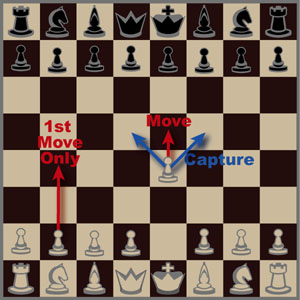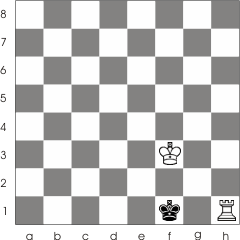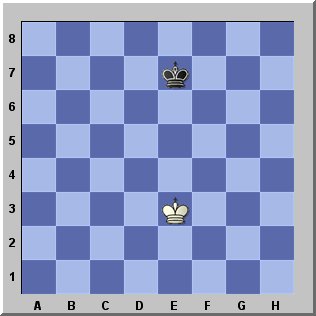Lesson Time: Chess Matters
Erm, teacher? Before we learn how to play chess, what is chess?
Ah! That's a very good question. A question many will not ask. But you're one of them aren't you? The kind who won't give up asking until you get a decent answer. I like that! Well, back to the subject: What is chess? Chess is a two-player strategic board game played on a chess board, a checkered gameboard with 64 squares arranged in an eight-by-eight grid. It is one of the most popular game in the world too. Each player starts the game with 16 pieces of 6 different types. Namely:
- 1 king
- 1 queen
- 2 rooks
- 2 knights
- 2 bishops
- 2 bishops
- 8 pawns
These 6 different chess pieces move differently. Your objective is to checkmate your opponent. In other words, use the chess pieces to force your opponent's king into a spot where the king is under the inescapable threat of capture and has nowhere to run. Should your opponent withdraw from the game voluntarily, you too, emerge as victor. However, the game could also end in a draw in many ways, where neither player wins.
Okay... So, where and when did chess come about?
Well to answer that question, we will have to go for a little field trip. Buckle your seat-belt and hop into the time machine! We're about to visit the past! Here, we go!
A long, long time ago, in a galaxy far, far away...
Well, it wasn't very far away, it was here, on Earth, but it was a long time ago... Chess' history spans some 1500 to 2000 years. The earliest predecessor of the game probably originated in India. From India, the game spread to Persia. Then, when the Arabs conquered Persia, chess entered the Muslim world and subsequently spread to Southern Europe. In Europe, it evolved roughly to its current form. in the 15th century.
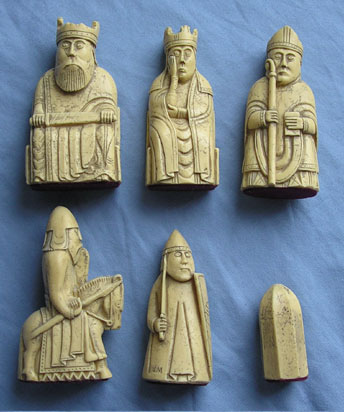 |
| Top row: King, Queen, Bishop Bottom Row: Knight, Rook, Pawn |
However, before chess evolved into "roughly its current form" the chess then was not like how you see it today. In those days, the board was more or less the same with dark-coloured tiles and white-coloured tiles but they were played with chess pieces like the kind on the right.
Looks a lot different from the chess pieces today like those at the bottom don't they?
 |
| Pawn, Rook, Knight, Bishop, Queen, King |
Watch the following video for more information on chess' history...
Okay then, enough with the background knowledge. Let's play chess! Erm, wait, how do you play chess?
Ah! Yes! You haven't learnt how to play chess yet, have you? Well, you know how the game roughly works, now, to move on to the details.
First, the chessboard. A chessboard is he type of checker board used in chess, and consists of 64 squares (eight rows and eight columns) arranged in two alternating colors (light and dark).
Now, the chess pieces. At the beginning of the game the chessboard is laid out so that each player has the light color square in the bottom right-hand side. The chess pieces are then arranged the same way each time. The second row (or rank) is filled with pawns. The rooks go in the corners, then the knights next to them, followed by the bishops, and finally the queen, who always goes on her own matching color (white queen on white, black queen on black), and the king on the remaining square.
So, when you're done, your chess pieces and chessboard should look something like that...
The player with the white pieces always moves first. Therefore, players generally decide who will get to be white by chance or luck such as flipping a coin or having one player guess the color of the hidden pawn in the other player's hand. White then makes a move, followed by black, then white again, then black and so on until the end of the game.
For more information on how to set up the chessboard, watch the following video...
I see! So, what are the important things again?
Okay, so, in short, here is your summary of chess.
Your Equipment:
16 chess pieces, namely:
- 8 Pawns
- 2 Rooks
- 2 Knights
- 2 Bishops
- 1 Queen
- 1 King
Your Objective:
Capture the opponent's King as son as possible while capturing other enemy pieces to boost the capture of your opponent's King and to also protect your own King.
Your Time:
The time taken is measured by a chess clock which can be either analogue or digital.
Since white starts first in a chess competition, black will be allowed to choose on which side of the chessboard can the clock be placed.
So, how the clock works is that after a person makes a move he stops his clock and thus starts his opponent's clock. The clocks countdown how much time each player has left to make all their moves before reaching the time limit. At the beginning of the game the clock of the player who has the white pieces is started.
When the minute hand is pointing towards the 12 a small flag falls. If a player has not made the specified number of moves when the flag falls he has lost the game on time unless the opponent has insufficient material to checkmate with. Then the game is drawn.
The amount of time you have depends on the kind of chess you are playing.
Blitz chess has a typical time limit of 5 minutes for each player for all of the moves.
Rapidplay has a typical time limit of 30 minutes for each player for all the moves.
Local league chess has a typical time control of 35 moves in 75 minutes and then perhaps 15 or 20 minutes to finish the game.
International chess has a standard time control of 40 moves in 2 hours and then an extra hour to reach move 60. After this, if the game is still in progress, a quickplay finish decides the game.
Ah! I see... But, what's the difference between the chess pieces?
Oh, yes. Chess pieces move in 6 different ways and all have different "abilities". Each of the 6 different kinds of pieces moves differently.
Pieces cannot move through other pieces (though the knight can jump over other pieces), and can never move onto a square with one of their own pieces. However, they can be moved to take the place of an opponent's piece which is then captured. Pieces are generally moved into positions where they can capture other pieces (by landing on their square and then replacing them), defend their own pieces in case of capture, or control important squares in the game. However, after they capture a piece, the player's move is over. The following looks into each and every chess piece.
The King
Name: King
Movement: 1 square in any direction
 The King is the most important piece in the chess game because if you lose your king, you lose everything. In other words you lose. So, if you are going to lose your king, you may now... =============>
The King is the most important piece in the chess game because if you lose your king, you lose everything. In other words you lose. So, if you are going to lose your king, you may now... =============>
 Well, at least its not entirely a sitting duck as it can only move one square in any direction (up, down, left, right and diagonally), shown in the diagram on the left. This also means any enemy piece in those 8 squares surrounding it can be captured.
Well, at least its not entirely a sitting duck as it can only move one square in any direction (up, down, left, right and diagonally), shown in the diagram on the left. This also means any enemy piece in those 8 squares surrounding it can be captured.
 For example, in the picture on the right, the squares the king can move to are highlighted in blue and his current position is marked by a yellow box. He can move onto any of the blue squares as well as capture any chess pieces on the squares (if there were pieces on those blue squares).
For example, in the picture on the right, the squares the king can move to are highlighted in blue and his current position is marked by a yellow box. He can move onto any of the blue squares as well as capture any chess pieces on the squares (if there were pieces on those blue squares).
 In the picture on the left, the Queen's position is marked in a yellow box. The squares she can move to are highlighted in blue. The squares in red are where the Queen can move to to capture the opponent's chess pieces. So, in this case, the Queen can eat any of the 3 pawns or the rook at the right hand corner. This shows just how powerful the Queen is in chess: the most.
In the picture on the left, the Queen's position is marked in a yellow box. The squares she can move to are highlighted in blue. The squares in red are where the Queen can move to to capture the opponent's chess pieces. So, in this case, the Queen can eat any of the 3 pawns or the rook at the right hand corner. This shows just how powerful the Queen is in chess: the most.
 The King is the most important piece in the chess game because if you lose your king, you lose everything. In other words you lose. So, if you are going to lose your king, you may now... =============>
The King is the most important piece in the chess game because if you lose your king, you lose everything. In other words you lose. So, if you are going to lose your king, you may now... =============>
 Well, at least its not entirely a sitting duck as it can only move one square in any direction (up, down, left, right and diagonally), shown in the diagram on the left. This also means any enemy piece in those 8 squares surrounding it can be captured.
Well, at least its not entirely a sitting duck as it can only move one square in any direction (up, down, left, right and diagonally), shown in the diagram on the left. This also means any enemy piece in those 8 squares surrounding it can be captured.
 For example, in the picture on the right, the squares the king can move to are highlighted in blue and his current position is marked by a yellow box. He can move onto any of the blue squares as well as capture any chess pieces on the squares (if there were pieces on those blue squares).
For example, in the picture on the right, the squares the king can move to are highlighted in blue and his current position is marked by a yellow box. He can move onto any of the blue squares as well as capture any chess pieces on the squares (if there were pieces on those blue squares).
Watch the following video for more information on the King...
The Queen
Name: Queen
Value: 9 out of 10
Movement: Unlimited squares in all directions
The Queen is the most powerful piece. As you can see in the diagram on your right, the Queen can move in any one straight direction - forward, backward, sideways, or diagonally although she cannot jump over chess pieces.
And, when in the middle, the Queen dominates 28 squares. Any unfortunate enemy piece caught in any one of these 28 squares can be captured. This is why the Queen is the second most important piece in chess, behind the King.
 In the picture on the left, the Queen's position is marked in a yellow box. The squares she can move to are highlighted in blue. The squares in red are where the Queen can move to to capture the opponent's chess pieces. So, in this case, the Queen can eat any of the 3 pawns or the rook at the right hand corner. This shows just how powerful the Queen is in chess: the most.
In the picture on the left, the Queen's position is marked in a yellow box. The squares she can move to are highlighted in blue. The squares in red are where the Queen can move to to capture the opponent's chess pieces. So, in this case, the Queen can eat any of the 3 pawns or the rook at the right hand corner. This shows just how powerful the Queen is in chess: the most.
Watch the following video for more information on the Queen...
The Rook
Name: Rook
Value: 5 out of 10
Movement: Unlimited squares in only 4 directions (up, down, left or right)
The Rook is not as strong as the Queen or important as the king but since they can travel for unlimited squares in the 4 directions, as shown in the diagram on the right, they are particularly powerful pieces especially when they are protecting each other and working together! But, having one of them is still better than none.
The Rook is able to move in all 4 directions. The yellow square represents the Rook's present position and the blue squares represent the places the Rook can move to while the red ones are where the rook can move to to capture the opponent's chess pieces. In this case, it can capture the opponent's Rook or Bishop.
The Rook is able to move in all 4 directions. The yellow square represents the Rook's present position and the blue squares represent the places the Rook can move to while the red ones are where the rook can move to to capture the opponent's chess pieces. In this case, it can capture the opponent's Rook or Bishop.
Watch the following video to learn more about the Rook...
The Bishop
Name: Bishop
Value: 3
Movement: Unlimited squares only diagonally
 As shown in the diagram on the right, the Bishop may move as far as it wants, but only diagonally.
Each Bishop starts on one color (light or dark) and must always stay on that color. Bishops work well together because they cover up each other’s weaknesses. Again, like the Rooks, they are also great on their own.
As shown in the diagram on the right, the Bishop may move as far as it wants, but only diagonally.
Each Bishop starts on one color (light or dark) and must always stay on that color. Bishops work well together because they cover up each other’s weaknesses. Again, like the Rooks, they are also great on their own.
 For example, in the picture on the left, the Bishop can move for unlimited squares diagonally. The yellow square represents the Bishop's current position, the blue ones represent the possible places the Bishop can move to and the red ones are the chess pieces the Bishop can capture. In this case, it can capture the opponent's Bishop, Pawn or Rook.
For example, in the picture on the left, the Bishop can move for unlimited squares diagonally. The yellow square represents the Bishop's current position, the blue ones represent the possible places the Bishop can move to and the red ones are the chess pieces the Bishop can capture. In this case, it can capture the opponent's Bishop, Pawn or Rook.
Watch the video below to find out more about the Bishop...
The Knight
Name: Knight
Value: 3
Movement: Any direction as long as it moves in a L-shaped way
 Knights move in a very different way from the other pieces – going two squares in one direction, and then one more move at a 90 degree angle, just like the shape of an “L”. For example, in the diagram on the right, the possible squares the Knight can move to are all in red with the squares highlighted in green representing the different paths the Knight can take before ending up on a red square. Notice whichever green path you take, by following a L-shaped movement, you will land on a red square.
Knights move in a very different way from the other pieces – going two squares in one direction, and then one more move at a 90 degree angle, just like the shape of an “L”. For example, in the diagram on the right, the possible squares the Knight can move to are all in red with the squares highlighted in green representing the different paths the Knight can take before ending up on a red square. Notice whichever green path you take, by following a L-shaped movement, you will land on a red square.
 So, in this scenario, the white Knight is able to move to all of its 8 possible locations (highlighted in blue and red) with 2 being the ones (the red ones) where the Knight can capture the enemy pieces, in this case, 2 pawns. Its current position is marked in yellow.
So, in this scenario, the white Knight is able to move to all of its 8 possible locations (highlighted in blue and red) with 2 being the ones (the red ones) where the Knight can capture the enemy pieces, in this case, 2 pawns. Its current position is marked in yellow.
Knights are also the only pieces that can move over other pieces...
Jump!? Like, really Jump!? Over all the chess pieces!?
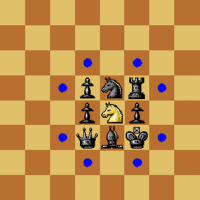 For example, in this picture you see on the left, the white Knight has been surrounded entirely by the opponent's chess pieces. Namely, a King, a Bishop, a Queen, 3 Pawns, a Rook and a Knight. Despite this, white's Knight can still jump over the pieces and in a L-shaped movement, land on any one of the squares marked with blue dots.
For example, in this picture you see on the left, the white Knight has been surrounded entirely by the opponent's chess pieces. Namely, a King, a Bishop, a Queen, 3 Pawns, a Rook and a Knight. Despite this, white's Knight can still jump over the pieces and in a L-shaped movement, land on any one of the squares marked with blue dots.
Watch the following video for more information...
The Pawn
Value: 1
Movement: 1 square forward, with exception of the first move of the pawn where it can move 1 or 2 squares ahead
Pawns are unusual because they move and capture in different ways: they move forward, but capture diagonally. Pawns can only move forward one square at a time, except for their very first move where they can move forward two squares. Pawns can only capture one square diagonally in front of them. They can never move or capture backwards. If there is another piece directly in front of a pawn he cannot move past or capture that piece.
En Passant
Also, do you know about en passant? “En passant,” is French for “in passing”. If a pawn moves out two squares on its first move, and by doing so lands to the side of an opponent’s pawn (effectively jumping past the other pawn’s ability to capture it), that other pawn has the option of capturing the first pawn as it passes by. This special move must be done immediately after the first pawn has moved past, otherwise the option to capture it is no longer available. Watch the following video to find out more on not just about en passant, but also on pawns...
Check & Checkmate
As stated before, the purpose of the game is to checkmate the opponent’s King. This happens when the King is put into check and cannot get out of check. There are only three ways a King can get out of check:
- Move out of the way (though he cannot castle)
- Block the check with another piece
- Capture the piece threatening the King
If a King cannot escape checkmate then the game is over. Customarily the King is not captured or removed from the board, the game is simply declared over.
Here is an example of check...
The battle is nearly up here. The number of pieces on each side are 6 from the original 16.
White tries to capture black's King by moving his Bishop to F5 where there is nothing in the way between the white Bishop and the black King.
But, hope is not lost for the black.
Blocking the oncoming attack from the King seems logical. Black thinks about moving his Bishop from E8 to D7 when he spots a better solution one that will not involve any sacrifices.
A possible solution is to retreat by moving the King backwards from C8 to B8 but this might not stop White from chasing the King. So, black figures out another plan
Black can capture the white Bishop by using his Rook: moving it from A5 to F5 where the Rook will can capture the Bishop and not get captured.
And that was exactly what Black did. White was caught by surprise and now, Black has successfully get his King out of check.
Here is another example of check...
White moves in fast. The game has gone on for only a short while before black's King has been checked.
White's Bishop is at C6, attempting to capture black's King.
Black panics and is frantically trying to see if he can block the attack. He thinks about shifting his Bishop from C8 to D7 to fend off the attack (instead of doing something stupid like shifting the Queen from D5 to D7 to block the attack).
Fortunately for black and unfortunately for white, black sees another solution. One that does not involve any sacrificial. Black thinks of retreating by placing his King at any of the 3 available squares: D8, E7 or F8 when he sees something even better: to get rid of the Bishop.
Black chooses one of the two choices he has: to use his Queen to capture the Bishop by moving it from D5 to C6 or simply using the Pawn at B7 to capture the Bishop by shifting it to C6.
Which way did Black choose? It doesn't matter, he has successfully gotten his King out of check.
Here is an example of checkmate...
The game has just started and already, there is a checkmate. White has played aggressively, bringing out the Queen whereas black's King still hasn't moved. White's Queen is now at H5 and black's King is right in the line of fire at F8. Black considers his options. He cannot block the checkmate with the Knight, Pawns or Bishop. Black now thinks of capturing white's Queen but none of his pieces are able to do so. Black now ponders over his last choice, to run away. But, there is nowhere for his King to run to. Still at its original position, the King cannot go behind and he is blocked in all directions except for one direction: which is where the Queen is attacking from. Moving in that direction will still result in hite's victory. The game is up and black has lost and victory goes to white!
WAIT!!!
Before we move on, let us clarify a misconception. Capturing your opponent's pieces is not your ultimate goal. Checkmating your opponent's King and ensuring your doesn't get checkmated is. So, watch the video below to find out more...
Occasionally chess games do not end with a winner, but with a draw. There are 5 reasons why a chess game may end in a draw:
- The position reaches a stalemate where it is one player’s turn to move, but his king is NOT in check and yet he does not have another legal move
- The players may simply agree to a draw and stop playing
- There are not enough pieces on the board to force a checkmate
- A player declares a draw if the same exact position is repeated three times (though not necessarily three times in a row)
- Fifty consecutive moves have been played where neither player has moved a pawn or captured a piece.
Here are examples of draws...
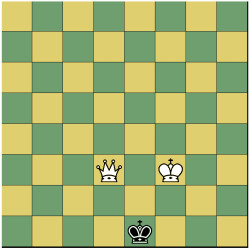 Black's King has been forced into a tight corner, more like edge actually. White's King and Queen wait mercilessly.
Black's King has been forced into a tight corner, more like edge actually. White's King and Queen wait mercilessly.
Here, it is black's turn to make a move. He is currently not in check but he does not have any legal moves. All the moves he can make will all result in him getting a checkmate.
If black chooses to move his King from E1 to F1, he will be captured by white's Queen.
If black moves his King to F2, he will be captured by white's King.
If black moves his King to E2, he will be captured by the Queen.
If black moves his King to D2 or D1, he will be captured by white's Queen.
So, with black not having any other moves that will not result in defeat or be in check, the game reaches a draw.
Here is another example of draws...
Here, in this game, there is no victor or loser. Yes, the game has reached a tie after both players have agreed to a draw and stop playing...
Another example of draw is this...
In this game, both white and black are left with nothing but their Kings. That is definitely not enough chess pieces on the board to force a checkmate! So, draw!
For more information, watch this video...
WOW! That was a long lesson teacher!
Yes! How about watching another YouTube video?
There's more?
Of course! Remember the pawn? It is actually stronger than it seems. With it, you can do a few tricks...
Promotion
Pawns have another special ability and that is that if a pawn reaches the other side of the board it can become any other chess piece (called promotion). A pawn may be promoted to any piece. [NOTE: A common misconception is that pawns may only be exchanged for a piece that has been captured. That is NOT true.] A pawn is usually promoted to a queen. Only pawns may be promoted. Watch this video to find out more...
Ah! I see...
Now, let us learn more about castling.
Castling
One other special rule is called castling. This move allows you to do two important things all in one move: get your king to safety (hopefully), and get your rook out of the corner and into the game. On a player’s turn he may move his king two squares over to one side and then move the rook from that side’s corner to right next to the king on the opposite side. However, in order to castle, the following conditions must be met:
- It must be that king’s very first move
- It must be that rook’s very first move
- There cannot be any pieces between the king and rook to move
- The king may not be in check, pass through check or castle into check
Watch the following video for more information...
WOW! That certainly was very enlightening teacher! Any other tips and tricks?
Plenty! Well... You are a beginner, so I will provide you with some tips before we go to the tricks and tactics.#1 Protect your king
 Your king is priority in chess. Lose your king and lose everything. If you fail to plan, you plan to fail. So, get your king to the corner of the board where he is usually safer. Don’t put off castling. You should usually castle as quickly as possible. Remember, it doesn’t matter how close you are to checkmating your opponent if your own king is checkmated first!
Your king is priority in chess. Lose your king and lose everything. If you fail to plan, you plan to fail. So, get your king to the corner of the board where he is usually safer. Don’t put off castling. You should usually castle as quickly as possible. Remember, it doesn’t matter how close you are to checkmating your opponent if your own king is checkmated first!
#2 Don’t give pieces away
Don’t carelessly lose your pieces! Each piece is valuable and you can’t win a game without pieces to checkmate. There is an easy system that most players use to keep track of the relative value of each chess piece. As shown in the picture:
- Pawn value: 1
- Knight value: 3
- Bishop value:3
Rook value: 5
- Queen value: 9
- King value: infinitely valuable
At the end of the game these points don’t mean anything – it is simply a system you can use to make decisions while playing, helping you know when to capture, exchange, or make other moves.
You should try and control the center of the board with your pieces and pawns. If you control the center, you will have more room to move your pieces and will make it harder for your opponent to find good squares for his pieces.
Give it your best shot and throw at your opponent everything you know. Do not hold back. Nobody will wait around for you to beat them. So, use all of your pieces! Your pieces don’t do any good when they are sitting back on the first row. Try and develop all of your pieces so that you have more to use when you attack the king. Using one or two pieces to attack will not work against any decent opponent.
#5 You just learnt how to play chess
 Even if it's not your first time playing chess, failure is inevitable. Most importantly you must absorb the lessons learnt and experiences from these defeats. Don't make the same mistake and learn from your opponent, whether is he or she your friend, parent or relative. Einstein wasn't born smart. Bill Gates wasn't born rich. Steve Jobs wasn't born with a blueprint for the iPhone. And, in case you haven't noticed, these people are all old or have already passed on. It takes EXPERIENCE. But, remember to dream big... Like how the pawn, one day, may capture the king...
Even if it's not your first time playing chess, failure is inevitable. Most importantly you must absorb the lessons learnt and experiences from these defeats. Don't make the same mistake and learn from your opponent, whether is he or she your friend, parent or relative. Einstein wasn't born smart. Bill Gates wasn't born rich. Steve Jobs wasn't born with a blueprint for the iPhone. And, in case you haven't noticed, these people are all old or have already passed on. It takes EXPERIENCE. But, remember to dream big... Like how the pawn, one day, may capture the king...
Okay! Tips taken! Are there any more?
Woah! Hold your horses there! Before you play chess. Just a few more tips!
If you want to get better at chess...
Knowing the rules and basic strategies is only the beginning - there is so much to learn in chess that you can never learn it all in a lifetime! To improve you need to do three things:
#1 – Play
Just keep playing! Play as much as possible. You should learn from each game – those you win and those you lose.
#2 – Study
If you really want to improve quickly then pick up a [recommended chess book]. There are also many resources on Chess.com to help you study and improve.
#3 Have fun
Don’t get discouraged if you don’t win all of your games right away. Everyone loses – even world champions. As long as you continue to have fun and learn from the games you lose then you can enjoy chess forever!
Okay! PLAYTIME!!!
Okay. Beginners can stop here and go play chess. Practice, practice, practice, you'll get better. As for the experts... Let's just say, stay and read on. But, let me first ask you a question. Do you find the following familiar?
How about this?
Chess Tactics
So you've read till here eh? Well, we've got nasty stuff for you now. Tonnes. To kill your opponents... in chess, of course. Tactics we are covering include:
- The Double Attack
- The Discovered Attack
- The Pin and the Skewer
Double Attack
So we begin our study of tactics with double attacks, or forks: moves that involve attack two enemy pieces at once. Let us first explore Knight Forks.
Why the Knight? Well, the Knight is a vicious and common forking tool. How?
1) It can threaten a wide range of targets. The Knight can not only attack or capture any unprotected enemy pieces, it can also be exchanged favorably for enemy Queens and Rooks regardless of whether they have protection or not.
2) The Knight's unique, non-straight pattern of movement creates two advantages: it allows attacking enemy pieces without fear of being captured and also enables a knight to make jumps and deliver threats surprising to the eye and so are easy to overlook.
3) To spot a chance for a knight fork, one will have to be habitually aware of the relationship between your Knights and opponent pieces (and between his knights with your chess pieces during defense). Every rank a Knight moves forward tends to bring it closer to one's forking targets, especially the King. Once a Knight reaches the 4th rank, it can attack the opponent's back rank and often, the King, in one move.
Here, the strategic importance of planting Knights on central and advanced squares and the tactical importance of constantly looking for forks your knight might be able to deliver once it has been properly developed has been demonstrated.
 In this picture on the right, it's white's turn to play. By shifting his Knight from H5 to F6 (from the red square to the green one), white has just carried out a Knight fork. Black will have to move his King somewhere else safer so that he will not be checkmated. This leaves the white Knight able to capture the black Rook.
The other forks like The Queen Fork, Bishop Fork, Rook Fork and Pawn Fork all work like how the Knight Fork works, targeting two enemy pieces at once, just that they are used by different pieces and that they are not used as commonly as The Knight Fork which is the most effective. So, the following are examples of each kind of fork.
In this picture on the right, it's white's turn to play. By shifting his Knight from H5 to F6 (from the red square to the green one), white has just carried out a Knight fork. Black will have to move his King somewhere else safer so that he will not be checkmated. This leaves the white Knight able to capture the black Rook.
The other forks like The Queen Fork, Bishop Fork, Rook Fork and Pawn Fork all work like how the Knight Fork works, targeting two enemy pieces at once, just that they are used by different pieces and that they are not used as commonly as The Knight Fork which is the most effective. So, the following are examples of each kind of fork.
 |
| Queen Fork |
 |
| Bishop Fork |
 |
| Rook Fork |
 |
| Pawn Fork |
The Discovered Attack
In a discovered attack or "discovery", one of your pieces moves out of the way of another, unleashing attacks on two enemy pieces at the same time -- one by the unmasking piece and the other by the piece just unmasked. The opponent will then have to choose to protect one of the threatened chess pieces. Whichever your opponent saves, you simply capture the other one (Unless he smartly moves "threatened piece 1" into a position to guard "threatened piece 2", anything that captures "threatened piece 2" will be captured by "threatened piece 1". In such cases, you will have to see which piece has a higher value. If your's is higher, don't capture, if your opponent's is, do it.). And THAT might just leave your enemy like this...
 |
| Defeated... |
 |
| The Knight |
So, discovered attacks always involve two pieces. One is the unmasking piece and the other, the piece unmasked. Every piece has the power to unmask attacks by other pieces by moving off of lines that it occupies. However, some pieces cannot be unmasked because they cannot be masked in the first place. What do I mean? For example, you know the Knight can jump over all chess pieces. The enemy will stay very wary of your Knights, so it will not come as an surprise to them if you unmask your Knight. In fact, your opponent might have already moved to defend itself from your oncoming discovered attack.
 |
| The Queen |
Conversely, the Queen is a very good chess piece to unmask for a discovered attack but it does not mask other pieces well. For example, your Queen cannot hide an attack from a Bishop or Rook because the Queen can do anything your Bishop or Rook can. So, the threats by both pieces are roughly the same. Besides, by using your Queen to mask other pieces, you are risking your most powerful piece. Hence, it is not recommended to use a Queen to mask other chess pieces.
The essence of a classic discovered attack is that before it is executed, neither piece poses as a direct threat to anything whereas after the unmasking, both of the pieces do.
Mastering discoveries means learning new ways to think about the pieces and the relationships between them. You may think of Bishops as pieces that attack diagonally and Rooks attack from back to forth and side to side. That is not wrong, just incomplete. This is why most people fail to see discovery attacks. They think of chess pieces as individual parts serving their own purposes, capturing their own pieces. Make it a point to think of all these chess pieces as partners, working together and whose efforts need to be coordinated to achieve a common goal. Individually, they are not much but together, they pack a punch.
So, the easiest piece to use for The Discovered Attack is the Bishop. Let me show you a few examples...
In this case, the Bishop Discovery is being used. The Bishop Discovery works when the Bishop masks another piece, which in this case, is a Rook. So, here, its white's turn. White has already carefully planned his Bishop Discovery.
White's Bishop is on G3 with the Rook behind it on G2. With one move, white moves his Bishop over to D6, unmasking the Rook.
At this point, the white Bishop on D6 can attack the black Knight on C5 whereas the piece which has just been unmasked, the white Rook, can capture the black Knight on G6.
If the opponent chooses to sacrifice the Knight on G6, then white will check the black King and somehow white will win. So, the opponent will sacrifice the Knight in C5 instead. Now, there you go, a captured enemy Knight.
The other discoveries, like The Rook Discovery, Knight Discovery and Pawn Discovery, work just like the Bishop Discovery, just that different chess pieces are used. Here are some examples of each kind of discovery...
 |
| Rook Discovery |
 |
| Knight Discovery |
 |
| Pawn Discovery |
The Pin and The Skewer
 Take the picture on the right as an example. White's Pawn on square 5D is pinned because if the pawn moves away, Black's Bishop can checkmate White immediately.
Take the picture on the right as an example. White's Pawn on square 5D is pinned because if the pawn moves away, Black's Bishop can checkmate White immediately.
Such pinned pieces are vulnerable targets for other chess pieces because normally, when a piece is threatened, it has the option of retreating and moving off but in such a case, it cannot as doing so will cause certain defeat. The only way to protect this pinned piece, is to rally other pieces to join this pinned piece for defense.
So, after a pin, it is recommended to attempt to eliminate the pinned piece with something with a lower value than the pinned piece so that in case something goes wrong on the way to the pinned piece, it is not so bad.
Often chess pieces from both sides rush to the pinned piece with one side wanting to rid it and the other side wanting to protect it from harm. The outcome often depends on the quantity and the value of chess pieces from both sides. Remember, on both sides, time is of essence. Each move made might lead to the enemy King moving off and you wasting all your turns.
 So, to prevent such a pin from stopping you from your victory, one will have to think through very carefully.
For example, in the picture on the left, it's Black's turn to play. However, if he moves Black Bishop away from square E5 to prepare to checkmate White's King, he would be leaving his own King defenseless to White's Rook. So, the Black Bishop is currently pinned. Black can only move his King out of the way. White then eats Black's Bishop with his Rook. Later, with his White Rook and King, White will then somehow be able to checkmate Black's King.
Those seem useful!
Yes they were. And those are not the only tactics...
Here are some more:
So, to prevent such a pin from stopping you from your victory, one will have to think through very carefully.
For example, in the picture on the left, it's Black's turn to play. However, if he moves Black Bishop away from square E5 to prepare to checkmate White's King, he would be leaving his own King defenseless to White's Rook. So, the Black Bishop is currently pinned. Black can only move his King out of the way. White then eats Black's Bishop with his Rook. Later, with his White Rook and King, White will then somehow be able to checkmate Black's King.
Those seem useful!
Yes they were. And those are not the only tactics...
Here are some more:
 So, to prevent such a pin from stopping you from your victory, one will have to think through very carefully.
For example, in the picture on the left, it's Black's turn to play. However, if he moves Black Bishop away from square E5 to prepare to checkmate White's King, he would be leaving his own King defenseless to White's Rook. So, the Black Bishop is currently pinned. Black can only move his King out of the way. White then eats Black's Bishop with his Rook. Later, with his White Rook and King, White will then somehow be able to checkmate Black's King.
Those seem useful!
Yes they were. And those are not the only tactics...
Here are some more:
So, to prevent such a pin from stopping you from your victory, one will have to think through very carefully.
For example, in the picture on the left, it's Black's turn to play. However, if he moves Black Bishop away from square E5 to prepare to checkmate White's King, he would be leaving his own King defenseless to White's Rook. So, the Black Bishop is currently pinned. Black can only move his King out of the way. White then eats Black's Bishop with his Rook. Later, with his White Rook and King, White will then somehow be able to checkmate Black's King.
Those seem useful!
Yes they were. And those are not the only tactics...
Here are some more:
- Mating Patterns
- Pawns Breakthrough
- Blockade
- Decoying
- Passed Pawn
- X-ray Attack
- Interception
- Deflection
- Pinz
- Demolition of Pawns
- Overloading
- Annihilation of Defense
- Pursuit (perpetual attack)
- Intermediate Move
- Space Clearance
- Removing the Guard
And, that is all for Chess Matters!
If you have made it till this point, then...
CONGRATULATIONS!!
You are now armed with everything you need to play chess! Remember to practise, practise, and PRACTISE!
Do give comments in the comment box below for updates and even more information.








